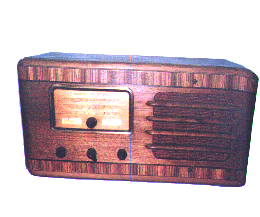
Late in the nineteenth century, Guglielmo Marconi began experimenting with electromagnetic waves to send signals. At that time, the telegraph wire was the quickest way to get messages from here to there, using Morse code. He designed a transmitter to send and a receiver to detect radio waves. By the end of the century Marconi had managed to send signals over several miles with no wires, and the idea was taking hold with naval officials. In 1898 he sent a wireless message 18 miles. In 1900 he patented his system.

On December 12, 1901, Marconi tried to send the first radio signals across the Atlantic Ocean, in spite of predictions that the radio waves would be lost as the earth curved over that long distance. He set up a specially designed wireless receiver in Newfoundland, Canada, using a coherer (a glass tube filled with iron filings) to conduct radio waves, and balloons to lift the antenna as high as possible. The signals were sent in Morse code from Poldhu, Cornwall, in England.
On Christmas Eve, 1906, wireless operators on ships off the New England coast wondered if they'd had a religious experience. Out of the midst of Morse code dots and dashes beeping through their headsets came the sound of a voice reading the Christmas story from the Gospel of Luke and a violin playing "Silent Night." The voice wished them a merry Christmas, and then the dots and dashes started up again.

The voice was that of Reginald Fessenden (1866-1932), an inventor and engineer who had been working on producing voice radio since Marconi's first wireless broadcast across the Atlantic. After his Christmas experiment, Fessenden continued working to make voice radio practical. In 1907, Lee de Forest invented a new radio tube called the Audion. It soon made transmitting sound modulations much more effective and became standard radio equipment. The radio tube was gradually improved upon by other inventors, to increased clarity and power.
For 15 years or so, voice radio was only used by engineers and hobbyists called hams. To most people it seemed amusing, but a novelty that would have no practical application. One obstacle to radio's acceptance was that the equipment was cumbersome and required a fair amount of knowledge and attention. After World War I, more appliances started to be used in the home and people got used to having such equipment at home. Radio companies formed to build and sell ready-made machines.

In 1920, Westinghouse, one of the leading radio manufacturers, had an idea for selling more radios: It would offer programming. Radio began as a way of one person talking to another person, so this was a novel idea. Dr. Frank Conrad was a Pittsburgh area ham operator with lots of connections. He frequently played records over the airwaves for the benefit of his friends. This was just the sort of thing Westinghouse had in mind, and it asked Conrad to help set up a regularly transmitting station in Pittsburgh. On November 2, 1920, station KDKA made the nation's first commercial broadcast (a term coined by Conrad himself). They chose that date because it was election day, and the power of radio was proven when people could hear the results of the presidential race before they read about it in the newspaper.
KDKA was a huge hit, inspiring other companies to take up broadcasting. In four years there were 600 commercial stations around the country. To keep up with the cost of improving equipment and paying for performers, stations turned to advertisers. In August 1922, the first radio ad, for a real estate developer, was aired in New York City. The growing industry made the airwaves so jammed and chaotic that the Federal Radio Commission was established in 1927 to assign frequencies to broadcasters.

The entry of mass communication into homes meant, among other things, the development of a mass culture. The same songs were heard across the country, news travelled fast, and heroes like Charles Lindbergh in a new way, accessible to all. Technological refinements in radio continued. Early in the 1920s, headsets were replaced with speakers. In 1929, FM radio became available. The development of the transistor in the late 1940s paved the way for the transistor radio's appearance in 1952. Stereophonic sound and personal stereos would continue radio's evolution.
During wartime, radio was very important for cheering people up with music they could listen to at home, or while they were working. But it also kept people in touch with what was going on. Stations had to be very careful what they said, because of course radio signals could be picked up by the enemy, and they could hear what was being said.

Spies who were working over in occupied Europe during World War Two often listened to the BBC to hear coded messages, that only they knew the meaning of. A message might sound like "The cow jumped over the moon", but it could mean that a certain mission was to go ahead on a particular date. If anyone in occupied Europe was found with a radio tuned to the BBC, they could be severely punished. Agents operating over there often carried their own radios, which they had to move around often, so the Germans could not find where they were transmitting from.